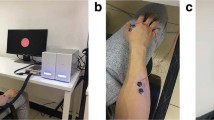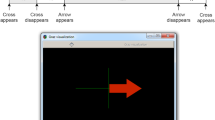Abstract
A motor-imagery-based brain–computer interface (BCI) is a translator that converts the motor intention of the brain into a control command to control external machines without muscles. Numerous motor-imagery-based BCIs have been successfully proposed in previous studies. However, several electroencephalogram (EEG) channels are typically required for providing sufficient information to maintain a specific accuracy and bit rate, and the bulk volume of these EEG machines is also inconvenient. A wearable motor imagery-based BCI system was proposed and implemented in this study. A wearable mechanical design with novel active comb-shaped dry electrodes was developed to measure EEG signals without conductive gels at hair sites, which is easy and convenient for users wearing the EEG machine. In addition, a wireless EEG acquisition module was also designed to measure EEG signals, which provides a user with more freedom of motion. The proposed wearable motor-imagery-based BCI system was validated using an electrical specifications test and a hand motor imagery experiment. Experimental results showed that the proposed wearable motor-imagery-based BCI system provides favorable signal quality for measuring EEG signals and detecting motor imagery.






Similar content being viewed by others
References
Mason, G. S., and Birch, E. G., A general framework for brain–computer interface design. IEEE Trans. Neural Syst. Rehabil. Eng. 11:70–85, 2003. doi:10.1109/TNSRE.2003.810426.
Donchin, E., Spencer, K. M., and Wijesinghe, R., The mental prosthesis: assessing the speed of a P300-based brain-computer interface. IEEE Trans. Neural Syst. Rehabil. Eng. 8:174–179, 2000. doi:10.1109/86.847808.
Piccionea, F., Giorgia, F., Tonina, P., Priftisa, K., Giovec, S., Silvonid, S., Palmasd, G., and Beverinad, F., P300-based brain computer interface: reliability and performance in healthy and paralysed participants. Clin. Neurophysiol. 17:531–537, 2006. doi:10.1016/j.clinph.2005.07.024.
Pfurtscheller, G., and Aranibar, A., Evaluation of event-related desynchronization (ERD) preceding and following voluntary self-paced movement. Electroencephalogr. Clin. Neurophysiol. 46:138–146, 1979. doi:10.1016/0013-4694(79)90063-4.
Pfurtscheller, G., Stancák, A., and Neuper, C., Event-related synchronization (ERS) in the alpha band – an electrophysiological correlate of cortical idling: a review. Int. J. Psychophysiol. 24:39–46, 1996. doi:10.1016/S0167-8760(96)00066-9.
Pfurtscheller, G., Functional topography during sensorimotor activation studied with event-related desynchronization mapping. J. Clin. Neurophysiol. 6:75–84, 1989. doi:10.1097/00004691-198901000-00003.
Pfurscheller, G., EEG event-related desynchronization (ERD) and event-related synchronization (ERS). In: Niedermeyer, E., and Silva, F. L. D. (Eds.), Electroencephalography: basic principles, clinical applications and related field, 4th edition. Williams and Wilkins, Baltimore, pp. 958–967, 1999.
Pfurscheller, G., and Neuper, C., Motor imagery and direct brain computer communication. Proc. IEEE 89:1123–1134, 2001. doi:10.1109/5.939829.
Pfurtscheller, G., Kalcher, J., Neuper, C., Flotzinger, D., and Pregenzer, M., On-line EEG classification during externally-paced hand movements using a neural network-based classifier. Electroencephalogr. Clin. Neurophysiol. 99:416–425, 1996. doi:10.1016/S0013-4694(96)95689-8.
Pfurtscheller, G., Neuper, C., Flotzinger, D., and Pregenzer, M., EEG-based discrimination between imagination of right and left hand movement. Electroencephalogr. Clin. Neurophysiol. 103:642–651, 1997. doi:10.1016/S0013-4694(97)00080-1.
Pfurtscheller, G., Schlögl, A., Brunner, C., and Silva, F. L., Mu rhythm (De)synchronization and EEG single-trial classification of different motor imagery tasks. NeuroImage 31:153–159, 2006. doi:10.1016/j.neuroimage.2005.12.003.
Lemm, S., Blankertz, B., Curio, G., and Müller, K. R., Spatio-spectral filters for improving the classification of single trial EEG. IEEE Trans. Biomed. Eng. 52:1541–1548, 2005. doi:10.1109/TBME.2005.851521.
Dornhege, G., Blankertz, B., Krauledat, M., Losch, F., Curio, G., and Muller, K. R., Combined optimization of spatial and temporal filters for improving brain-computer interfacing. IEEE Trans. Biomed. Eng. 53:2274–2281, 2006. doi:10.1109/TBME.2006.883649.
Sannelli, C., Braunand, M., and Müller, K. R., Improving BCI performance by task-related trial pruning. Neural Netw. 22:1295–1304, 2009. doi:10.1016/j.neunet.2009.08.006.
Mcfarland, D., Mccane, L., David, S. V., and Wolpaw, J. R., Spatial filter selection for EEG-based communication. Electroencephalogr. Clin. Neurophysiol. 103:386–394, 1997. doi:10.1016/S0013-4694(97)00022-2.
Rodríguez-Bermúdez, G., and García-Laencina, P. J., Automatic and adaptive classification of electroencephalographic signals for brain computer interfaces. J. Med. Syst. 36:51–63, 2012. doi:10.1007/s10916-012-9893-4.
Huang, Y. J., Wu, C. Y., Wong, A. M., and Lin, B. S., Novel active comb-shaped dry electrode for EEG measurement in hairy site. IEEE Trans. Biomed. Eng. 62:256–263, 2015. doi:10.1109/TBME.2014.2347318.
Pfurtscheller, G., Solis-Escalante, T., Ortner, R., Linortner, P., and Müller-Putz, G. R., Self-paced operation of an SSVEP-based orthosis with and without an imagery-based brain switch: a feasibility study towards a hybrid BCI. IEEE Trans. Neural Syst. Rehabil. Eng.. 18:409–414, 2010. doi:10.1109/TNSRE.2010.2040837.
Qin, L., and He, B., A wavelet-based time–frequency analysis approach for classification of motor imagery for brain–computer interface applications. J. Neural Eng. 2:65–72, 2005. doi:10.1088/1741-2560/2/4/001.
Lotte, F., Congedo, M., Lecuyer, A., Lamarche, F., and Arnaldi, B., A review of classification algorithms for EEG-based brain computer interface. J. Neural Eng. 4:1–24, 2007. doi:10.1088/1741-2560/4/2/R01.
Khare, V., Santhosh, J., Anand, S., and Bhatia, M., Classification of five mental tasks based on two methods of neural network. Int. J. Comput. Sci. Inf. Secur. 8:86–92, 2010.
Broomhead, D. S., and Lowe, D., Multivariable functional interpolation and adaptive network. Complex Syst. 2:321–355, 1988.
Pierce, J. R., An introduction to information theory: symbols. Signals and Noise, Dover, New York, 1980.
Muller-Putz, G. R., Kaiser, V., Solis-Escalante, T., and Pfurtscheller, G., Fast set-up asynchronous brain-switch based on detection of foot motor imagery in 1-channel EEG. Med. Biol. Eng. 48:229–233, 2010. doi: 10.1007/s11517-009-0572-7.
Yamawaki, N., Wilke, C., and Liu, Z., An enhanced time-frequency-spatial approach for motor imagery classification. IEEE Trans. Neural Syst. Rehabil. Eng. 14:250–254, 2006. doi: 10.1109/TNSRE.2006.875567.
Hazrati, M. K., and Erfanian, A., An online EEG-based brain–computer interface for controlling hand grasp using an adaptive probabilistic neural network. Med. Eng. Phys. 32:730–739, 2010. doi: 10.1016/j.medengphy.2010.04.016.
Muller, K. R., Tangermann, M., Dornhege, G., Krauledat, M., Curio, G., and Blankertz, B., Machine learning for real-time single-trial EEG-analysis: from brain-computer interfacing to mental state monitoring. J. Neurosci. Methods 167:82–90, 2008. doi: 10.1016/j.jneumeth.2007.09.022.
Lehtonen, J., Jylänki, P., Kauhanen, L., and Sams, M., Online classification of single EEG trials during finger movement. IEEE Trans. Biomed. Eng. 55:713–720, 2008. doi: 10.1109/TBME.2007.912653 .
Acknowledgments
This research was partly supported by Ministry of Science and Technology in Taiwan, under grants MOST 103-2221-E-009-035-MY2, and MOST 104-2221-E-305-006. This research was also partly supported by Southern Taiwan Science Park Bureau, Tainan, Taiwan, under the grant CZ-12-12-22-103.
Author information
Authors and Affiliations
Corresponding author
Additional information
This article is part of the Topical Collection on Systems-Level Quality Improvement
Rights and permissions
About this article
Cite this article
Lin, BS., Pan, JS., Chu, TY. et al. Development of a Wearable Motor-Imagery-Based Brain–Computer Interface. J Med Syst 40, 71 (2016). https://doi.org/10.1007/s10916-015-0429-6
Received:
Accepted:
Published:
DOI: https://doi.org/10.1007/s10916-015-0429-6




